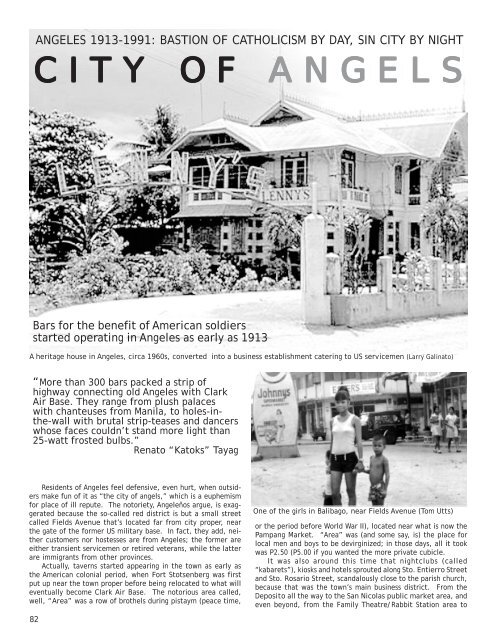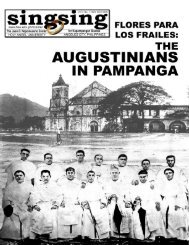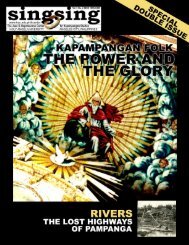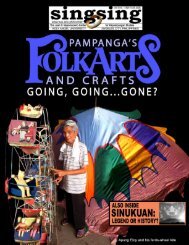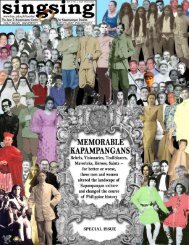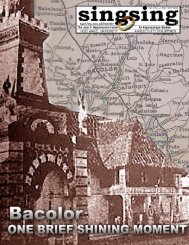Download PDF - Holy Angel University
Download PDF - Holy Angel University
Download PDF - Holy Angel University
You also want an ePaper? Increase the reach of your titles
YUMPU automatically turns print PDFs into web optimized ePapers that Google loves.
CITY CITY OF OF ANGELS<br />
ANGELS<br />
Residents of <strong>Angel</strong>es feel defensive, even hurt, when outsiders<br />
make fun of it as “the city of angels,” which is a euphemism<br />
for place of ill repute. The notoriety, <strong>Angel</strong>eños argue, is exaggerated<br />
because the so-called red district is but a small street<br />
called Fields Avenue that’s located far from city proper, near<br />
the gate of the former US military base. In fact, they add, neither<br />
customers nor hostesses are from <strong>Angel</strong>es; the former are<br />
either transient servicemen or retired veterans, while the latter<br />
are immigrants from other provinces.<br />
Actually, taverns started appearing in the town as early as<br />
the American colonial period, when Fort Stotsenberg was first<br />
put up near the town proper before being relocated to what will<br />
eventually become Clark Air Base. The notorious area called,<br />
well, “Area” was a row of brothels during pistaym (peace time,<br />
82<br />
ANGELES 1913-1991: BASTION OF CATHOLICISM BY DAY, SIN CITY BY NIGHT<br />
Bars for the benefit of American soldiers<br />
started operating in <strong>Angel</strong>es as early as 1913<br />
A heritage house in <strong>Angel</strong>es, circa 1960s, converted into a business establishment catering to US servicemen (Larry Galinato)<br />
“More than 300 bars packed a strip of<br />
highway connecting old <strong>Angel</strong>es with Clark<br />
Air Base. They range from plush palaces<br />
with chanteuses from Manila, to holes-inthe-wall<br />
with brutal strip-teases and dancers<br />
whose faces couldn’t stand more light than<br />
25-watt frosted bulbs.” Renato “Katoks” Tayag<br />
One of the girls in Balibago, near Fields Avenue (Tom Utts)<br />
or the period before World War II), located near what is now the<br />
Pampang Market. “Area” was (and some say, is) the place for<br />
local men and boys to be devirginized; in those days, all it took<br />
was P2.50 (P5.00 if you wanted the more private cubicle.<br />
It was also around this time that nightclubs (called<br />
“kabarets”), kiosks and hotels sprouted along Sto. Entierro Street<br />
and Sto. Rosario Street, scandalously close to the parish church,<br />
because that was the town’s main business district. From the<br />
Deposito all the way to the San Nicolas public market area, and<br />
even beyond, from the Family Theatre/Rabbit Station area to


